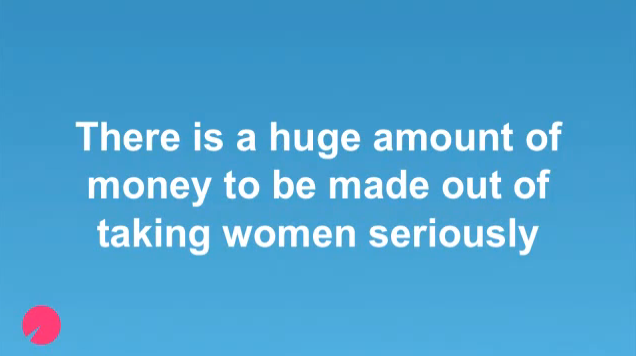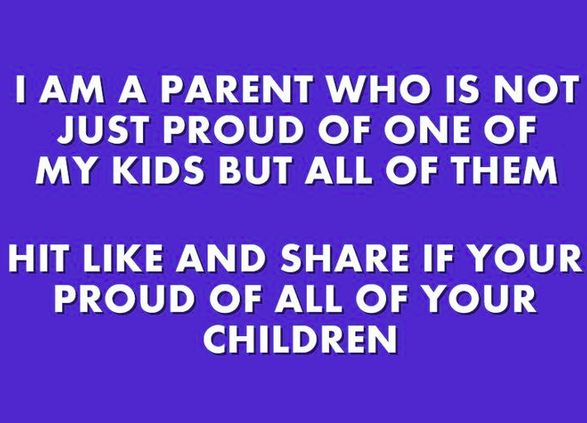Get Free Press For Your Startup With Original Data
Getting traditional PR coverage is hard! As new startups flood journalists with lame press releases, how do you stand out from the pack? Will Flaherty of SeatGeek taught "Data Driven PR" at General Assembly today.
Startups have a treasure trove of valuable, propriety data regarding some aspect of their given vertical. When packaged in a digestible and usable format to the right journalists, it will get you mentioned. Although it may not be a love story about your company, it will get you more free press.
What kind of data do you have?
Demographics about your audience
Trends in your marketplace
What Your Data Can Lead To
Print: Stories were created from data sent to individual writers.
Radio
TV: Since television is a visual medium, they place the highest value on giving them someone who is immediately available to be on camera. This means you need someone who can talk knowledgeably and is willing to meet a camera crew wherever local news crews are.
Infographics: These are produced by SeatGeek and take about 15-20 hours to produce. You'll notice in their Final Four infographic that they partnered with Seamless to get even more interesting data.
How to Pitch Data
Create a couple of hypotheses around a topic that your audience might find newsworthy. SeatGeek picks a type of event and location to focus their analysis on based on which news outlets they want to attract. It's faster to chase existing stories in news (like the Super Bowl) and provide data to earn mentions. SeatGeek has also done well digging up deep data on an original story to get higher quality mentions.
Pull the raw numbers into something like Excel and analyze it while keeping an open mind for new findings.
Synthesize the trends you're seeing in the data. What are the changes over time, locations, etc. Write compelling punch bullet points.
Create a visual element (graph/infographic) to convey your data in a different and powerful way. (Don't forget to include your logo & URL on the graphic)
Push the pitch out to interested journalists, bloggers, and media members.
Building Your List of Media Members To Pitch
Find the media members who are writing stories in your locale/vertical/etc. If you know one site that perfectly epitomizes the readership you're looking for, copy their URL. Then do a Google search for "related:URL.com" to see the sites that are similar to them.
Most of the time, their email address will be listed on their stories or website. If not you can use a few tricks to find it.
If they work for an organization with a common email structure like first.last@company.com you can use that. You can use Gmail tools like Rapportive to confirm your guess.
You can search the journalist's tweets for their email address using sites like Snap Bird. Just enter the target's Twitter name and the search term "email".
How to Contextualize Your Data Points
Comparison: How do prices/demand/profits compare to others or past? How do customers in your area compare to other areas?
Superlatives: Most expensive/popular thing in X years.
Trends: How is prices/profits/demand changing over time.
If Statements: If you bought all components individually would it be cheaper than buying them individually? If you had bought this widget it the past, what would it be worth now?
Use Google Alerts to track what are popular story topics in your industry.
Writing Your Pitch
Punchy, description subject line. Use an actual data point that will stand out to a journalist drowning in story pitches.
Personalized opening paragraph. Make it clear this isn't a stock email to hundreds of people. Mention your specific relationship with them whenever possible.
Crisp, clear data points. Write in complete sentences (that the journalist can copy) and bold the numbers you're pitching.
Always provide a link. Encourage the journalist to link to your site by providing a landing page that supports the story (hopefully a page that puts readers a click away from a transaction with you).
Give them a method to follow up. Make yourself available to provide more data or provide a quote. Will uses a Google voice number that forwards to his cell phone (which I thought would be great for scaling later on, if you want to have different folks answer at different times).
Check It Out
OkCupid (a dating site) pulled aggregated data on their users to create buzz-worthy blog posts and earn press mentions in the New York Times.
Yipit (a daily deal aggregator) has become the go-to source on daily deal industry metrics. They produce detailed data reports that they sell to the other daily deal sites and the financial community.
7 Reasons You Should Focus on Women in Your Advertising & Your Business
Gallop's keynote is required watching for men & women – she teaches us how businesses are missing out on innovative ideas & profits by staying male-centric.
Cindy Gallop opened the second 3% Conference in San Francisco, named because only 3% of Creative Directors in advertising are women. Gallop's keynote is required watching for men and women, as she teaches us how businesses are missing out on innovative ideas and ultimately profits by staying male-centric.
Key Takeaways
- Women ARE your target audience. Women are no longer a "niche" marketing target. They make the majority of purchases in almost every sector and are key purchasing influencers in every sector (even traditionally male-dominated ones). Women influence 60% of car purchases and 90% of technology purchases. Women are even the majority of gamers today, if you include social gaming.
- "Women share the sh*t out of everything." At any social gathering listen to the men talk about sports scores while the women share their experiences. Women have shared their experiences to build intimacy since the world began so it's no mystery why today they are the majority of social media users.
- Women get stuff done. Even if your product is aimed at men, Ms. Gallop recommends targeting your advertising at women. Women are the norm. Men are now the niche audience. There is a ton of money to be made by taking women seriously.
- Marketing done with women through the male perspective is no longer acceptable. When the 97% of Creative Directors are men, you gets ads that don't feature women in dynamic, engaging, and aspirational roles – instead you only see women as mothers, girlfriends, and sidekicks. We need a new approach to creativity – created by women, presented to female Creative Directors, for female clients.
- "Women challenge the status quo because we are never it." Women innovate and women disrupt. If you want your company to be innovative, find every department run by an all-white-male team and add women to it.
- "Women notice things that men don't." They notice relationships. They notice how people communicate. They notice how to get people to work together more cooperatively naturally and intuitively. Women notice the things that will make your company run better than it does today.
- "Women get sh*t done." How many women do you know that support men by doing the things they don't want to do? From the laundry to Sheryl Sandberg operating Facebook so Mark Zuckerberg can do what he really wants to do. The men who recognize this can still be the stars of the show but have a much smoother operation behind the scenes.
Your To Do List
Cindy Gallop implores men and women to do the following things to help change this culture, and ultimately make a ton of money.
- Call It Out. If nobody says anything, nothing will change. Every time you see a conference with an all-male line-up – say something. Every time the junior male account rep tries to take over a meeting you should be running – say something. It doesn't require being angry, it just requires pointing it out, because gender bias is often unconscious. You have to "break the closed loop of white guys talking to other white guys about white guys."
- Put Yourself Forward. Women who don't promote themselves help this male-dominated cycle continue. Gallop cites how there's been a ton of outrage over Twitter's lack of female board members but women she knows (and are highly qualified) hesitate even nominating themselves to advise a new startup.
- Redesign the Business. Business has been built for centuries around a male model of command and control, which is perfectly logical because, for centuries, women weren't allowed to work. The Future of Business is about complementing that with female values – collaboration, consensus building, and community. The system of business today is based around men going to work and women staying at home to support them. The reason we don't have enough women in leadership is because the very system is built to work for men and not the women who shoulder an unfair amount of the home support work. When women look up at the men running their organizations and see the grueling hours, they opt-out. But why have we designed every position at the top to be so unbearable? It doesn't have to be. Gallop challenges us to redesign a bite-size chunk of how something is done at your company. Redesign it the way you want to work and point to it as an example of how a redesigned business process makes work better for everyone.
Gallop believes the business model of the future is "shared values + shared action = shared profit (financial & social)". This is the business model she urges brands to adopt. Go beyond "co-creation" and pursue "co-action" between brands and people to benefit everyone. This business model also applies to men and women working together to create a world that we will all love working and living in.
Watch It!
Classy Social Media #FAIL Recoveries that Dr. Phil Should Learn From
As in all things in life, mistakes happen on social media. What really matters is how you respond when something you post isn't received as you planned. Here's two celebrities that Dr. Phil could learn from on how to talk to outraged fans.
As in all things in life, mistakes happen on social media. What really matters is how you respond when something you post isn't received as you planned. Here's two celebrities that Dr. Phil could learn from on how to talk to outraged fans.
Regina Spektor's Fans Tell Her To Shut Up And Sing
Regina shows a lot of class and thoughtfulness in responding to her (mostly white and southern) fans who disagree with her the George Zimmerman verdict.
I understand that the Trayvon Martin trial is a hot button issue but this is a Facebook page- it's for writing. If you think I should shut up and sing (by definition an impossible act:-) then perhaps you should just not upset yourself, spare your blood pressure, and unlike this page. Also feel free to only listen to music by people you agree with. It's all good! There's room enough for everyone in this world and moments like these are a great opportunity for people to find some new places to like or unlike.
Her original post.... Reactions to her post were generally positive but attracted many critical comments, many directly attacking her...
Reactions to her post were generally positive but attracted many critical comments, many directly attacking her... Regina's excellent social media recovery...
Regina's excellent social media recovery...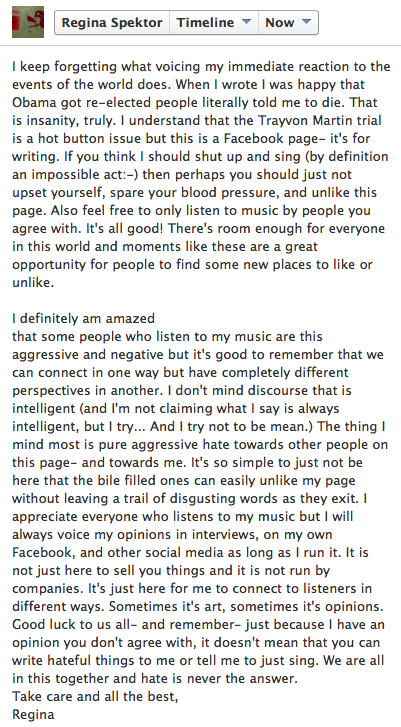
George Takei's Staff Goes Too Far
You're likely to offend some of your fans at some point. Check out the original post and excellent apology from George Takei over using a controversial topic to talk about parenting. And here's his (or his staff's) well thought out response. Notice it gets twice as many likes as the original post it is responding too. Your fans understand mistakes will be made, your job is to listen and respond with candor.
And here's his (or his staff's) well thought out response. Notice it gets twice as many likes as the original post it is responding too. Your fans understand mistakes will be made, your job is to listen and respond with candor.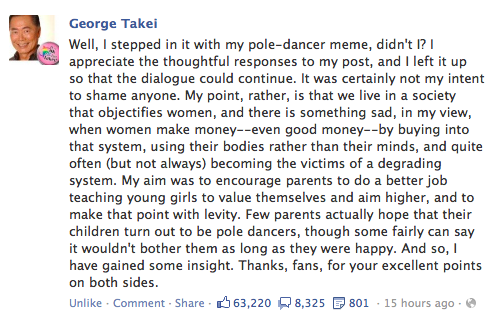
Dr. Phil Fails to Respond to his Twitter #FAIL
The Twitterverse went crazy over a tweet that Dr. Phil's twitter staff rapidly took down. Their mistake was not apologizing publicly, which instigated a Change.org petition to start circulating.Here's the original tweet: A sampling of the viral lashing he received for it:
A sampling of the viral lashing he received for it: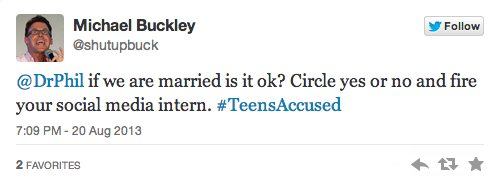
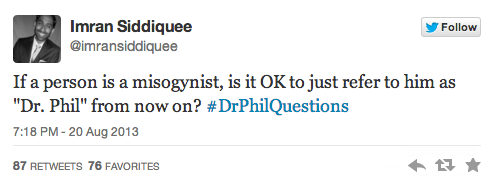 We'll see if Dr. Phil takes the hint and apologizes to his fans. In case you're reading this "social media intern who just got fired," here's some hints on how to respond in the future.
We'll see if Dr. Phil takes the hint and apologizes to his fans. In case you're reading this "social media intern who just got fired," here's some hints on how to respond in the future.
A Few Hints On Responding to Social Media Fails
- Platform: Typically you're going to want to use the same platform that the original fail occurred on to respond. However, it can be stronger to record a short video or write a longer blog post and link out to that apology to get the audience back on your "home turf" so to speak. If you're considering doing so on your own blog, you might want to turn off comments or monitor them closely.
- Timing: You need to be thoughtful but you also need to do this quick! The internet doesn't forget easily.
- Candor: If you've screwed up be honest about it. Tell your fans what you're going to do to make sure this doesn't happen in the future. Thank your fans for teaching you something. Apologize for making an honest mistake and most of your fans will believe you.
- Don't Give Up: Just because a mistake has been made, doesn't mean social media isn't worth your time. Social media is about conversations and you've just started a big one!
3 Types of Facebook Like Bait
hese examples from the top pages on Facebook show three ways they are winning likes easily to get later messages out for free.
As you know, from my post on Facebook's Edgerank algorithm, how often your updates are shown to your fans (for free) depend on factors including how often they like or comment on your posts. These examples from the top pages on Facebook show three ways they are winning likes easily to get later messages out for free.
Seasonal: Celebrate What's Now
This Happy Easter post from Barack Obama's page received over 380,000 likes.
Recognition: New Text On An Old Meme
This repost by George Takei got over 70,000 likes. Mr. Takei's page has nearly 4 million followers. I would guess he has a professional social media expert helping him or he's just the the most "with it" celebrity I've encountered of his generation.
Guilt: You're a Bad person If you Don't Agree
This example from Hit Like If You Agree had over 59,000 shares. What mom on Facebook wouldn't share this.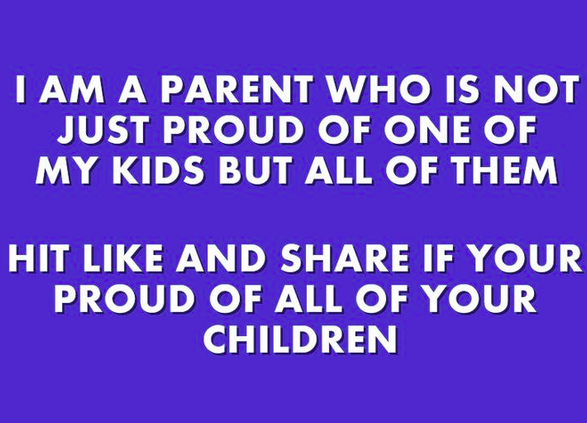
Bonus: Recovering When You Go Too Far
You're likely to offend some of your fans at some point. Check out the original post and excellent apology from George Takei over using a controversial topic to talk about parenting. And here's his (or his staff's) well thought out response. Notice it gets twice as many likes as the original post it is responding too. Your fans understand mistakes will be made, your job is to listen and respond with candor.
And here's his (or his staff's) well thought out response. Notice it gets twice as many likes as the original post it is responding too. Your fans understand mistakes will be made, your job is to listen and respond with candor.
Changing Behavior With Persuasive Technology
Design with the intent to change someone's behavior or attitude is a skill every startup and non-profit needs to master to get better results from their customers and communities.
 I attended Behavior Change: As Value Proposition, given by Chris Risdon (@chrisrisdon, #behaviordesign) at SXSW Interactive in Austin.Changing behavior is hard:
I attended Behavior Change: As Value Proposition, given by Chris Risdon (@chrisrisdon, #behaviordesign) at SXSW Interactive in Austin.Changing behavior is hard:
- Why do you drive short distances when you could easily walk and be healthier?
- Why do you avoid going to the dentist when you know waiting longer will make your dental problems worse?
Using Opportune Moments
In 2004, you see a story about a Tsunami while waiting in the airport, which is followed by a commercial to donate to the Red Cross. You're moved to donate but then you have to take a flight, get home, unpack, and feed the dog. Maybe you remember to go to the Red Cross website but now you have to decide how much to donate, figure out your credit card billing information, and so on.In 2010, you saw the Haiti Tsunami story at the airport. You could text "Haiti" to 90999 and donate $10 via your cell phone bill to the Red Cross. This much simpler process matched the timing of the trigger and took advantage of your motivation in the moment.
Behavior Design
Design with the intent to change someone's behavior or attitude.
A bitter nail polish makes your finger nails taste bitter so you don't chew your nails. A study of countries by how many people volunteered for organ donation showed that countries had radically different rates because of the how they designed the sign-up process. Countries where you had to opt OUT of organ donation, had the majority of people registered for organ donation. Countries which made you opt IN to organ donation had the lowest rates. Just by changing the form process, you are able to design for your intended result, these are called "good defaults".
Persuasive Technology
Technology designed to persuade the user to use a system or platform in a desired way.
Amazon one-click is an example of a process designed to make purchasing easier. Instead of building a cart and comtemplating shipping charges, you're one click away from making a simple purchase. In the product space, software and services make it plain that you are trying to help the user organize their travel plans (TripIt) or finances (Mint). More and more of these sites use highly personal data to help you change your own behavior.
The New "Me" Generation
Products and services designed and marketed on the premise that their befits – the value received – are specific behavior-based outcomes.
- Data collection is a primary feature: Nike FitBand collects data on your physical activity throughout the day.
- System makes recommendation or guidance: Mint recommends credit card with less fees based on your purchasing data.
- Behavior is measurable: Users can see their progress.
- Prescriptive/Constrained self-determination: Service narrows options to guide user to their chosen outcome.
Sensors & Data
If it can be connected, it will be connected in the Internet of Things.
Sensors using GPS, Accelerometers, RFID, etc., measure everything from where we go to how fast we can bounce a basketball. Consumers are becoming less and less afraid of giving services access to personal data. Mint has convinced thousands of users to give them the login information for all their financial accounts.
Feedback and Feedforward
The progression from weighing at your weekly WeightWatchers meeting to a WiFi-connected scale that tracks you daily, illustrates how personal sensors can provide better timed feedback. Feedforward is proactive service design that gives you information before you make the decision instead of just showing you the results. Chris spoke about how at Subway sandwich shops he always intends to each a healthy sandwich but ends up buying the cookies at the end. What if a service detected he's entering the Subway and tells him how many calories he'd have to burn to get those cookies?
Framing & Profiling
Not everyone is motivated in the same way. Some folks need a cheerleader to "ra-ra" them up the hill, others need a drill sergeant to scare them into running harder. This is called "Persuasion Profiling," which means each one of us has a different set of triggers that will persuade us to act differently. Just in the wording of a choice, you can guide behavior.
Collection > Visualization > Story
We understand how to use the technology to show users their behavior but do we understand that every design decision influences the user? Documentaries demonstrate that HOW we tell a story changes people's perception, and eventually their behavior. Next stop let's go beyond the graph and show people how to change their word.
More Resources on Behavior Design
14 Keys to Great Retail Merchandising
Today, I learned how boring all my store display ideas are from Bob Phibbs, "the Retail Doctor", at the Apple Specialist Conference in Austin.
Why Merchandise?
It raises your average purchase amount by silently adding-on to every sale.
Turns mission shoppers into browsers and makes them curious about what else you offer.
Great Merchandising...
Is simple and fast to understand.
Slows down a customer's eyes
Is coherent and logical (you don't put diapers next to vodka)
It groups products that a certain type of customers are likely going to buy (you put products for seniors in one display, not mixed with products for parents and teenagers)
What is the message you want to send?
We have this in five colors?
We have sales stuff?
Here's the full picture of what you need.
4 Types of Bad Displays
Illogical groupings of products that don't work together.
Crammed displays with too many choices.
Half empty displays where the fixture stands out more than the product.
Add more signs (if the first signs didn't work, add more).
6 Types of Good Displays
Complimentary displays: paper towels with window cleaner or waffles with pancake syrup.
Coordinated displays: all the things you need to do "X" (all the accessories you need to paint a room).
Environmental/lifestyle displays: Shows the products in use or reasons to buy the product visually. Garden bug spray with big panels on what type of damage bugs do and how to use the spray.
One product type displays: Can be strong but are often dangerous. All the belts hung together are great if you're looking for a belt but you're going to skip it if you didn't intend to buy a belt.
Stand out displays: Intrigue the mind by putting something unexpected. Hang 30 light bulbs and turn one on.
Stop displays: Displays that make you stop to figure it out but don't have anything to do with the product you're selling.
How to Do Great Merchandising
Start at the Front Door: Make a front window display that makes it clear there is something new (or arrange the old product in a way that makes it look different).
Plan Inventory: Make sure you have inventory to support the sales of whatever you feature.
Find one Thing to Unify: A theme or purpose that everything works together on.
Build the Biggest Add-on: Accessorize a complete outfit.
Pay Attention to Color: Add more color or coordinate colors if possible.
Vary Heights: Put products at multiple levels. Products on counters encourage customers to touch them. Customers are more likely to buy anything they touch. Products on walls have less engagement.
Consider Something Different: A "pig in the window" is something that engages a customer with color, movement, or oddity. Put a moving train in your window and people will watch it. Put a toilet in your window to sell waterproof iPhone cases. Generic signs kill good displays. If the copy doesn't provoke a reaction, you've failed.
Lighting: Focus on what you want to sell the most. Show the customer where to look.
Proper Signage Helps Educate Your Customer: Make the customer feel smart. Anytime a customer has a question or feels intimidated they won't buy.
Sell the System: Put all the accessories you need together. All the ingredients for a recipe put together.
Keep It Sparkling: Clean all the your displays daily. Clean your front doors hourly.
Monitor Sales: Decode whether placement or product drove sales. Move a display every two weeks to different parts of the store and monitor the sales in different locations. You'll find you have hot spots and cold spots on the floor for placement.
Clear Pricing: Don't make anyone guess what your products cost.
Brand Your Signage: Young customers are likely to take pictures of fun displays, make sure your branding shows up with it.



